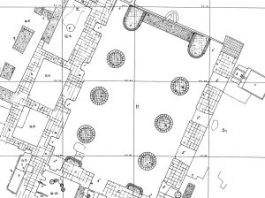Name
Chāl Tarkhān چال ترخان
Ali Mousavi, January 4th, 2024
Location: Chāl Tarkhān is the name of a Sasanian manor house in the plain of Reyy, central northern Iran, Tehran Province.
35°29’35.9″N 51°29’40.1″E
Map
Historical Period
Sasanian, Islamic
History and description
Chāl Tarkhān or Chāl Talkhān is the name of a ruined Sasanian site in the proximity of the village of Chāl Tarkhān and Eshqābād, 20 km southeast of Rayy. Situated in the plain of Rayy, the site is part of a group of well-known Sasanian and Early Islamic archaeological sites. The site comprises two distinct areas: a mud-brick citadel built on a 12-meter mound, and the Palace area, located 100 m to the north, the remains of which are almost destroyed today.
The citadel has dimensions of 80 x 80 meters and comprises a square building with an inner courtyard, surrounded by rooms. In the absence of archaeological excavations, the Citadel has been dated based on its plan and surface pottery to the early Islamic period.
The palace area covers approximately 2.4 hectares, including two sectors: the Main Palace with a columned hall (fig. 1) and a secondary palace with a small columned hall. The central part of the Main Palace was probably a vaulted reception hall with dimensions of 15 x 20 meters, including two rows of 3 large circular columns or piers (2 m in diameter) decorated with stuccos.
Archaeological Exploration
Archaeological sites in the plain of Rayy were subject to antiquities looting activities as early as the 1900s. Attention to Chāl Tarkhān primarily arose due to illicit excavations that supplied stucco fragments for the local and international art markets in the 1920s. This is why Erich Schmidt, who had previously conducted fieldwork in Rayy, excavated in the Palace area in 1936 during a joint expedition of the Pennsylvania Museum and the Museum of Fine Arts in Boston. No detailed report of the excavation was published. In 1969, the stuccos from the site were the subject of a doctoral dissertation by Deborah Lucy Thompson who included a chapter on the architectural remains.
Finds
A large number of stucco fragments were discovered in excavations aside from those found in the whereabouts of the site and are now attributed to Chāl Tarkhān. Other finds consist of potsherds of the late Sasanian/early Islamic period, late Sasanian coins, and 29 ostraca, of which 4 bear Arabic texts.
Bibliography
Holod, R., “The Medieval and Early Modern Islamic and Persianate City,” Journey to the City. Companion to the Middle East Galleries at the Penn Museum, edited by. S. Tinney and K. Sonik, Philadelphia, 2019, pp. 335-338 (for Chāl Tarkhān).
Kleiss, W., “Čal Tarkhan südöstlich von Rey,” Archaeologische Mitteilungen aus Iran, vol. 20, 1987, pp. 309-318.
Kröger, J., “Čāl Tarḵān”, Encyclopaedia Iranica Online, © Trustees of Columbia University in the City of New York.
Pourbakhshandeh, Kh., Gozāresh-e Pajūheshi: Barresi va shenāsā’i-ye āsār-e bāstāni va tārikhi-farhangi-ye howze-ye farmāndāri-ye Rey, Tehran, 1381/2002.
Pourbakhshandeh, Kh., “Moarefi-ye ejmāli-ye Reyy va fehrest-e āsār-e tarikhi-farhangi-ye ān,” Pazhūheshnāmeh, vol. 5, 1381/2002, pp. 190-216.
Schmidt, E. F., Flights over Ancient Cities of Iran, Chicago, 1940, p. 33, pls. 39-40 (for Chāl Tarkhān).
Thompson, D., Stucco from Chal Tarkhan-Eshqabad near Rayy, Warminster, 1976.



 DOWNLOAD AS PDF
DOWNLOAD AS PDF

















































































































